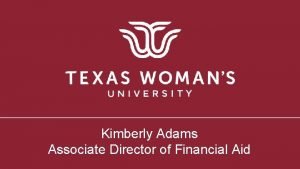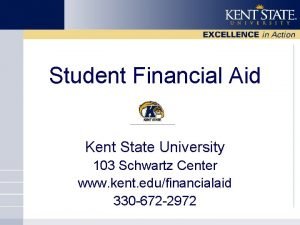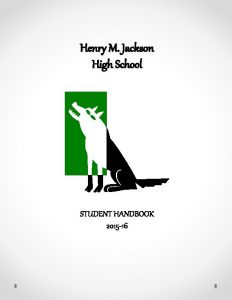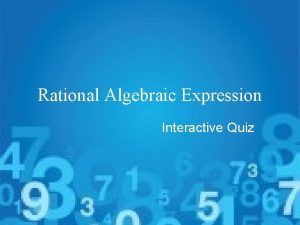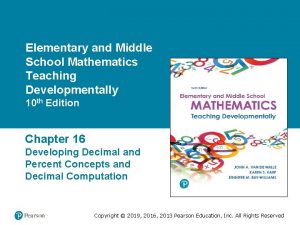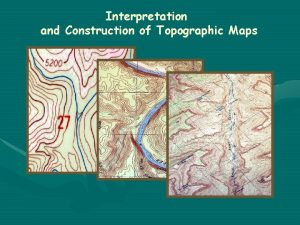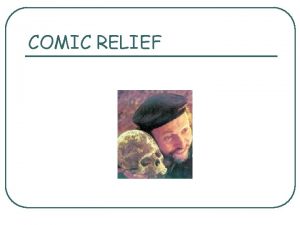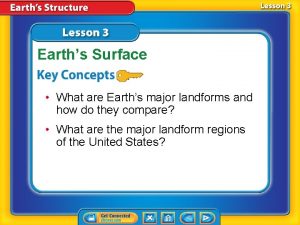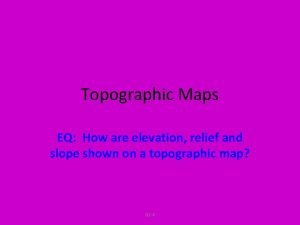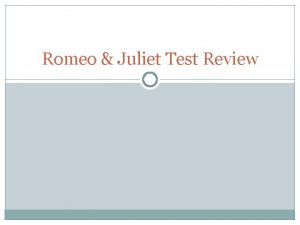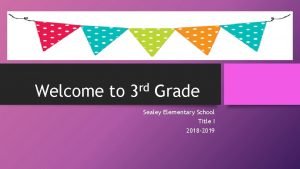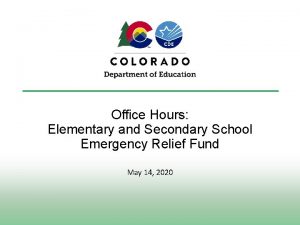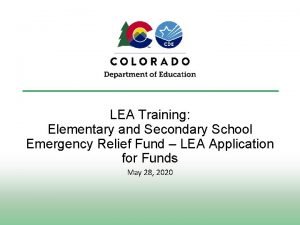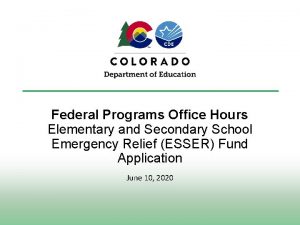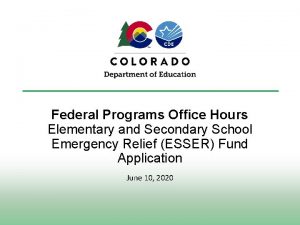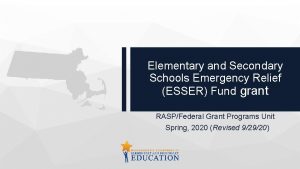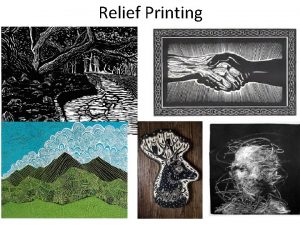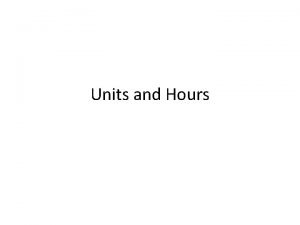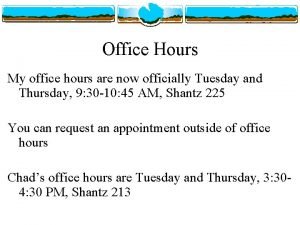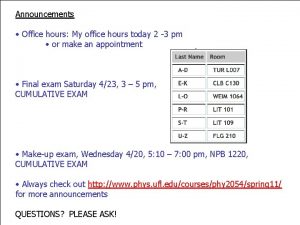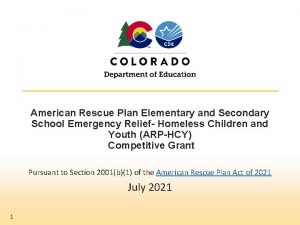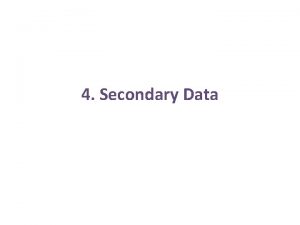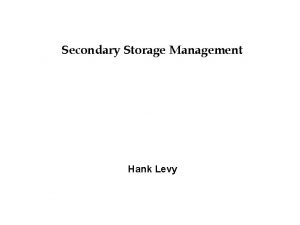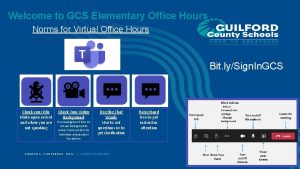Office Hours Elementary and Secondary School Emergency Relief

































- Slides: 33

Office Hours: Elementary and Secondary School Emergency Relief Funds May 22, 2020

Agenda for Today’s Office Hours • Update and explanation of the Various CARES Grants • Provide guidance on • Calculating proportionate share for Non-public schools • Providing supports and services to charter schools • Responses to FAQs • USDE Fact Sheet: COVID-19 and English Learners 2

CARES Grants CARES Act Education Stabilization Funds (ESF) Elementary & Secondary School Emergency Relief Funds (ESSER) $120 million ESSER Funds – Formula (90%) to LEAs $108 million Title I formula to LEA 3 Governor’s Emergency Education Relief (GEER) $44 million TBD ESSER Funds – State Level $12 million TBD (survey) CARES Relief Funds (CRF) Title V Governor’s Executive Order Education Relief $500 million PPA to LEA

ESSER Funds under the CARES Act Education Stabilization Section • Elementary and Secondary School Emergency Relief Fund • Over $13. 2 billion. SEA-administered. • Funds flow from ED to SEAs, which then must allocate not less than 90 percent of the funding to LEAs, based on share of Title I in FY 2019. • LEAs may use funds for: o Any activity authorized under ESEA, IDEA, Perkins, Adult Education and Family Literacy, or Mc. Kinney-Vento, and o Many other activities to help with the response to COVID 19 (including preparedness and response efforts, sanitation, professional development, distance learning, and others). • SEAs may use up to 10% for state level activities for emergency needs as determined by the SEA to address issues related to COVID-19 • SEAs may use some funds for administration (0. 5%) and the rest for emergency needs to respond to the coronavirus as determined by the SEA. Colorado ESSER: $120, 993, 782 LEA’s 90%: $108, 894, 404 SEA’s 10%: $12, 099, 378 SEA Admin: $604, 969

Equitable Services: All Public Schools, Including Charters 5

Statutory Requirements • The CARES Act does not directly address allocation of district ESSER funds to charter schools that are not standalone LEAs. • The clear legislative intent, however, is to benefit all public schools and students regardless of school type. See, e. g. , CARES Act Sec. 18003(d)(3). • CDE asks that districts include their charter schools on equal footing with traditional schools, when determining the most important educational needs as a result of COVID-19, consistent with the intent of the CARES Act and the intent of Colorado law, see C. R. S. 22 -30. 5 -112(3). 6

Implementation In Colorado • LEAs must meaningfully engage all school leaders, including charter school leaders, in determining their plans for using ESSER funds. • In the LEA application • List of locations provided in the budget but not required to budget at the school level except for non-public schools • Assurance that needs associated with COVID-19 for all students and educators in public schools, including charter schools, in the LEA have been considered and funds are being used to address impact of COVID-19 • Reminder: • While ESSER allocations are calculated using the Title I formula, these funds may be used for any allowable activities under ESSER to benefit all students and teachers in participating schools and are not subject to Title I requirements (e. g. , rank order, SNS) 7

Equitable Services to Non-Public Schools: Calculating Proportionate Share 8

Equitable Services to Non-Public Schools: What We Know • Section 18005 of the CARES Act: • LEA receiving funds under ESSER or GEER funds shall provide equitable services in the same manner as provided under Section 1117 of the ESEA to students and teachers in non-public schools as determined in consultation with representatives of non-public schools. • LEA allocations from the 90% • LEA grants under the 10% state reserve • LEA grants under GEER • USDE FAQ Document ~ non-regulatory guidance ~ April 30, 2020 • All students enrolled in NPS (not just Title I eligible) are used for calculating proportionate share • Not-for-profit NPS in the LEA boundary (not residency of student) 9

Proportionate Share: What We Know • Allocation of ESSER Funds Calculations • USDE to SEA • Based on Title I formula, proportionate share of ESSER funds to Colorado • CDE to LEA • Based on Title I formula, proportionate share of Colorado’s ESSER funds to each LEA • Non-Public Schools Proportionate Share • Under Title I Section 1117, non-public schools proportion share is based upon the number of eligible students who live within the district’s participating school attendance areas but attend nonpublic schools 10

Equitable Services to Non-Public Schools: Implementation in Colorado • Discrepancy between statutory language and nonbinding guidance • CDE is inclined to follow the plain language of the law-that “equitable services” to non-public schools be provided in the “same manner” as Title I Section 1117 • Unknown - USDOE may clarify its guidance or try to require LEAs to allocate funds in the manner articulated in guidance. • Given this uncertainty, LEAs might want to plan for the need for additional funds to be allocated for equitable services. 11

So Where Does that Leave Us? Q. Must LEAs that receive ESSER funds provide equitable services to non-public schools? • Yes. LEAs that receive ESSER funds are required to provide equitable services to students and staff in non-public schools, in compliance with Section 1117 of ESEA. Control of funds reserved for equitable services and items purchased with the funds must remain in public control. CDE will use the list of Non-Public Schools with school codes to prepopulate the LEA application; LEAs can add and update the system with new schools. https: //www. cde. state. co. us/datapipeline/nonpublic_schools All schools must have been in operation on March 13, 2020! Must have a school code! Form on the link above.

Calculating Proportionate Share for Non. Public School Equitable Services • In the LEA application, CDE will follow the formula in Section 1117 • non-public schools proportion share is based upon the number of eligible students who live within the district’s participating school attendance areas but attend non-public schools • Assurance that all non-public schools in the LEA have been consulted and provided the opportunity to participate in equitable services • LEAs may update the Non-Public School Section of the LEA application as needed • Reminder: • While ESSER allocations are calculated using the Title I formula, these funds may be used for any allowable activities under ESSER to benefit all students and teachers in participating schools and are not subject to Title I requirements (e. g. , rank order, SNS) 13

Example: Calculation in the LEA Application Online Platform *Only Non-Public Schools participating under CARES Act programs. 14

New FAQs 15

Non-Public Schools • Which schools must be provided opportunity to participate in equitable services under ESSER funds? • All not for profit non-public schools in the LEA’s boundaries, regardless of prior participation or decline to participate in ESEAfunded equitable services. • If all NPS have to be contacted, what deadlines are there for holding consultations with these new schools if they are included? • It is up to the LEA to set the deadline for responding. It has to be a reasonable amount of time and the timeline must be communicated to the non-public school. Consider basing the deadline on prior response time from NPS in the LEA boundaries. LEA's application for ESSER funds might be delayed if there is a delay in hearing back from non-public school. 16

Non-Public Schools • What is considered to be a "good faith effort" in trying to reach non-public schools? • This is up to the LEA to determine. Consider what efforts have been made in the past and which modes of communication produced the most timely and number of responses from NPS in the LEA boundary. CDE recommends a minimum of 2 attempts using 2 different modalities (e. g. , phone and email). 17

Declines in State and Local Funding • Can a district facing severe financial crisis in regards to state/local funds, use federal funds to provide basic, general educational services? • Consider using CARES Relief Funds first. LEAs received per pupil allocations under CARES Relief Funds (CRF) by Executive Order from the Governor for this purpose. After CRF funds, consider using ESSER funds for this purpose. If still have needs after those funding sources have been considered and used, then contact your ESEA Regional Contact to consider various allowable activities under Titles I-IV. 18

State and Other Federal Funding – Other than ESEA or ESSER • Can LEAs get an extension on funding timelines or reporting deadlines for various grants? • ESEA Programs Office does not track all the reporting for grants other than ESEA Titles IA, II-V, Title I School Improvement, and ESSER formula funds. We do not want to give misinformation. It is best to reach out directly to grant coordinators at CDE. Let us know if you need help figuring who to contact at CDE for each grant. • Here is a list of CDE contacts for some of the grants: • • 19 21 st Century – Dana Scott at scott_d@cde. state. co. us Mc. Kinney-Vento Act – Kerry Wrenick at wrenick_k@cde. state. co. us Migrant Education Program – Tomas Mejia at mejia_t@cde. state. co. us Competitive Grants – Kim Burnham at burnham_k@cde. state. co. us

LEA Application Signatures • Will the LEA application for ESSER funds require local board presentations or signatures? • The LEA is required to follow local policies and protocols for obtaining necessary grant signatures, informing the school board of grant funding, and uses of funds, as well as informing the local board of the decision to apply for ESSER funds and the plans for the use of funds. Therefore, the ESSER fund application can be submitted with the signature of the superintendent or district leadership authorized to sign grant applications on behalf of the district in accordance to the LEAs local policy. 20

Accounting Questions • What accounting codes will be used for ESSER Funds? • The 90% of funds being allocated to LEAs will be under 47 SD – Distribution (90% of the award). • Will time and effort be required if we pay for salaries out of ESSER funds? • Just as any federal grant, various federal legislations apply to ESSER funds. For example, if salary is paid with federal funds, T&E is generally required. A grantee must maintain appropriate records and cost documentation as required by 2 CFR § 200. 302(financial management), 2 CFR § 200. 430(i) (standards for documenting personnel expenses), and 2 CFR § 200. 333(retention requirements for records) to substantiate the charging of any compensation costs related to interruption of operations or services. For a list of application federal requirements, see assurances listed in LEA application [insert link when ready] or SEA's Certification and Agreement for ESSER funds [insert link to our application to USDE for these funds]. 21

COVID-19 fact sheet for English learners from the US Department of Education 22

About this Resource • Fact Sheet: Providing Services to English Learners During the COVID-19 Outbreak released on May 18 th, 2020 • Provides information about the following topics: o o o o 23 Annual English language proficiency Assessment Entrance requirements Providing services to ELs Use of Title III funds Exit procedures Parents of ELs Resources

Funding Considerations 24

Guidance for ESSER and GEER Funds: Supporting ELs 25 Federal Laws Related to ELs Funding Source Annual ELP Assessment State Local Funding Ensure Meaningful communication with parents of Els in a language they can understand SEAs and LEAs can generally use CARES Act funds under the ESSERF and GEERF for communications with parents, including translation and interpretation services. Entrance Requirements Funds received under the Elementary and Secondary School Emergency Relief Fund (ESSERF) or the Governor’s Emergency Education Relief Fund (GEERF) of the Coronavirus Aid, Relief, and Economic Security Act (CARES Act)3 , enacted on March 27, 2020, can generally be used for these purposes. Providing Services to Els in Content Classes Funds received under the ESSERF or the GEERF of the CARES Act can generally be used for these purposes and are not subject to supplement- not- supplant requirements.

Guidance for ESSER and GEER Funds: Purchasing Technology 26 Funding Initiative Funding Source General internet access and technology for access to EL students Recipients of subgrants under the CARES Act ESSERF and GEERF can generally use those grants for student internet access and devices to enable online learning as well as accessible technology for ELs with disabilities, among other uses of funds.

Use of Title III Funds Questions 1. If an LEA is providing remote learning, may funds under Title III of ESEA provide support for ELs by purchasing software for ELs in the content areas, or would that be considered supplanting? 2. If an LEA provides for internet access, hotspots, and tablets or other devices for low-income students who do not have access to technology, may Title III funds provide similar resources for those low-income students who are ELs to enable their internet access? 3. May Title III funds be used to train teachers to use new online platforms and software designed for ELs? Does that training need to be limited to training EL teachers or may the LEA include all teachers who have ELs in their classes? 27

Supports & Resources: • For more information § Contact: Morgan Cox, Title III and CLDE Director: cox_m@cde. state. co. us § Contact: Robert Thompson, Title III Consultant at Thompson_R@cde. state. co. us • Fact Sheet: Providing Services to English Learners During the COVID-19 Outbreak • COVID-19 and ESEA Resources • USDE Guidance around using Technology 28

Next Two Office Hours • Thursday, May 28, 2020, Noon to 2: 00 • Planning and Submitting LEA Applications for ESSER Funds and Allowable Uses of Funds Under ESSER and ESEA • Thursday, June 4, 2020, 1: 00 to 3: 00 • Continuing Conversations of Allowable Uses of Funds • • • 29 Perkins Career and Technical Education (CTE) Act Individuals with Disabilities Education Act (IDEA) Mc. Kinney-Vento Act Adult Education and Family Literacy Act (AEFLA) ESEA

Remaining Questions? Topics for Future Office Hours? 30

ESEA Office Position Phone E-mail Nazie Mohajeri-Nelson Director of ESEA Office 303 -866 -6205 Mohajerinelson_n@cde. state. co. us De. Lilah Collins Assistant Director of ESEA Office 303 -866 -6850 Collins_d@cde. state. co. us Michelle Prael Program Support 303 -866 -6998 prael_m@cde. state. co. us ESEA Team Region & Program Expertise Phone E-mail Brad Bylsma Director of Support Coordinators 303 -866 -6937 bylsma_b@cde. state. co. us Kristen Collins Northwest & West Central, Title V and Consolidated Application 303 -866 -6705 collins_k@cde. state. co. us Tammy Giessinger Pikes Peak & Southeast, Title IV and School Improvement 303 -866 -6992 giessinger_t@cde. state. co. us Karen Ingalls North Central & Northeast, Title I Lead 303 -866 -3897 Ingalls_k@cde. state. co. us Jeremy Meredith Southwest, Title II 303 -866 -3905 meredith_j@cde. state. co. us Laura Meushaw Pikes Peak & Southeast, Titles I and School Improvement 303 -866 -6618 meushaw_l@cde. state. co. us Robert Thompson Northwest & West Central, Title III 303 -866 -6842 thompson_r@cde. state. co. us Barb Vassis North Central & Northeast, Titles I and II 303 -866 -6065 vassis_b@cde. state. co. us Joey Willett Southwest, Titles I and ID, Monitoring 303 -866 -6700 willett_j@cde. state. co. us 31

ESEA Office (Cont. ) ESEA Office Position Phone E-mail Nazie Mohajeri-Nelson Director of ESEA Office 303 -866 -6205 Mohajeri-nelson_n@cde. state. co. us De. Lilah Collins Asst. Director of ESEA Office 303 -866 -6850 Collins_d@cde. state. co. us CGA Team Program Expertise Phone E-mail Kim Burnham Competitive, Grants & Awards Supervisor 303 -866 -6916 Burnham_K@cde. state. co. us Patricia Gleason Senior Consultant, Grants & Awards 303 -866 -6143 Gleason_P@cde. state. co. us Mandy Christensen Senior Consultant, Grants & Awards 303 -866 -6250 Christensen_m@cde. state. co. us Brittany Jimenez Program Support 303 -866 -6813 Jimenez_B@cde. state. co. us DARE Team Expertise Phone Email Tina Negley ESSA Accountability, Program Evaluation, and Reporting 303 -866 -5243 negley_t@cde. state. co. us Alan Shimmin ESEA Reporting and Data Collections 303 -866 -6209 shimmin_a@cde. state. co. us Mary Shen ESEA Program Evaluation, Research, and Accountability 303 -866 -4571 shen_m@cde. state. co. us 32

Grants Fiscal Contacts Grants Fiscal Staff Program Expertise Phone E-mail Jennifer Austin Director of Grants Fiscal 303 -866 -6689 Austin_j@cde. state. co. us Robert Hawkins Grants Fiscal Analyst 303 -866 -6775 Hawkins_r@cde. state. co. us Steven Kaleda Grants Fiscal Analyst 303 -866 -6724 kaleda_s@cde. state. co. us 33
 Ebra new deal
Ebra new deal Twu bursar
Twu bursar Michael schwartz center kent state
Michael schwartz center kent state Csudh financial aid number
Csudh financial aid number Instructor office hours
Instructor office hours Japanese high school sports uniform
Japanese high school sports uniform Henry m jackson bell schedule
Henry m jackson bell schedule Jean ribault middle school
Jean ribault middle school Coral springs middle school
Coral springs middle school Angelo can complete his school project in x hours
Angelo can complete his school project in x hours Pinellas park middle school
Pinellas park middle school Factory office layout
Factory office layout Elementary and middle school mathematics 10th edition
Elementary and middle school mathematics 10th edition Art that breaks the rules; artifice over nature.
Art that breaks the rules; artifice over nature. Outlining of master cast
Outlining of master cast On a planimetric map the tells you the number
On a planimetric map the tells you the number Examples of relief recovery and reform
Examples of relief recovery and reform Comic relief in hamlet
Comic relief in hamlet Landforms with low relief and high elevation
Landforms with low relief and high elevation Relief and physiography
Relief and physiography Afforestation advantages and disadvantages
Afforestation advantages and disadvantages Limiting structures of maxilla
Limiting structures of maxilla Elevation
Elevation Thou hast comforted me marvelous much
Thou hast comforted me marvelous much World development and relief
World development and relief Romeo and juliet test with answer key
Romeo and juliet test with answer key Ubujan elementary school
Ubujan elementary school Family portal schoolmax
Family portal schoolmax Mackay elementary school tenafly
Mackay elementary school tenafly Sealey elementary school
Sealey elementary school Leila davis elementary school
Leila davis elementary school Wexford elementary
Wexford elementary Kistler elementary school
Kistler elementary school Belcher bingo coupons
Belcher bingo coupons

